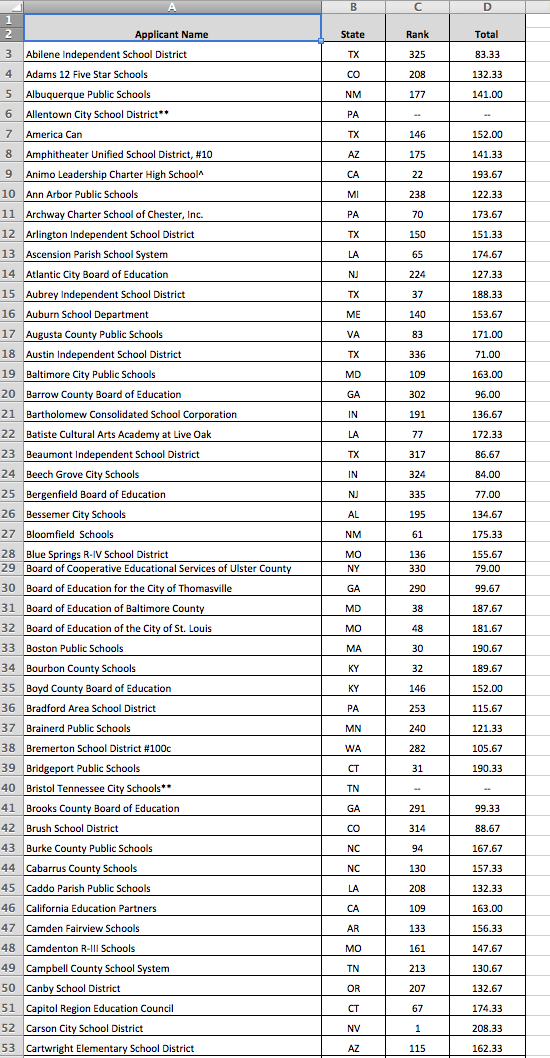Race to the Top Results are In: 16 Winners, More than 300 Losers
The Race to the Top continues with the announcement that 16 educational organizations including charter organizations, urban schools, and consortia, will share about $400 million. According to the U.S. Department of Education website, 16 applicants, representing 55 school districts in 11 states and D.C.–have won the 2012 Race to the Top-District competition. The $400 million will be used improve achievement and educator effectiveness, close achievement gaps, and prepare every student for college and career. They will receive 4-year awards ranging from $10 million to $40 million.
The winners were the top scorers among the 347 contestants. The 16 winners were selected from 61 finalists. Scores were determined by a panels of experts who used a scoring tool after receiving training in D.C. on how to evaluate the proposals. More than 290 reviewers were assigned randomly to read three or four proposals such that each entry was read by three panelists. After a conference phone call among each panel, final scoring was completed. Of the 347, those with a mean score of 178 (out of 210) were identified as finalists. Panels reading the top 61 applications came to DC for the week of November 26 to make the final cut to 16.
Winners
- Carson City School District,Nevada (This link will take you to the technical review form, with reviewers comments for Carson City Schools. Link here to see all the finalists technical review forms.
- Charleston County School District, South Carolina
- Galt Joint Union School District, California
- Green River Regional Educational Cooperative, Kentucky, consortium leader (consortium members: Adair County Schools, Campbellsville Independent Schools, Carroll County Schools, Caverna Independent Schools, Cloverport Independent Schools, Daviess County Schools, Green County Schools, Hart County Schools, Henry County Schools, Logan County Schools, Metcalfe County Schools, Monroe County Schools, Ohio Valley Educational Cooperative, Owen County Schools, Owensboro Independent Schools, Russell County Schools, Shelby County Schools, Simpson County Schools, Spencer County Schools, Taylor County Schools, Trimble County Schools, Union County Schools, West Point Independent Schools)
- Guilford County Schools, North Carolina
- Harmony Science Academy (Harmony Public Schools), Texas, consortium leader (consortium members: Harmony School of Excellence, Harmony School of Science-Houston, Harmony Science Academy-Austin, Harmony Science Academy-Brownsville, Harmony Science Academy-El Paso, Harmony Science Academy-Fort Worth, Harmony Science Academy-Lubbock, Harmony Science Academy-San Antonio, Harmony Science Academy-Waco)
- IDEA Public Schools, Texas
- Iredell-Statesville Schools, North Carolina
- KIPP DC, Washington, D.C.
- Lindsay Unified School District, California
- Metropolitan School District of Warren Township, Indiana
- Middletown City School District, New York
- New Haven Unified School District, California
- Puget Sound Educational Service District, Washington, consortium leader (consortium members: Auburn School District, Federal Way Public Schools, Highline Public Schools, Kent School District, Renton School District, Seattle Public Schools, Tukwila School District)
- School Board of Miami-Dade County, Florida
- St. Vrain Valley Schools, Colorado
The Losers
There are too many to list here, but you can see the complete list of applicants, their scores, and ranks among the 372 school organizations. Here is an alphabetical listing of the first 50 applicants, all of whom were not winners.

Figure 1. Listing of some of the districts that lost in the Race to the Top District Competition for $400 million.
It is interesting to note the terms that are used to differentiate between winners and losers in this school competition include “winners circle,” “snagged the largest grants,” “hungry to drive reform,” “the contest,” “great track record in competitions.”
Competition has become a crucial element in school reform, and there are many that believe that without the desire to win, no one would have the incentive to be disciplined, and progress would be suffer.
Arne Duncan says that there are zero politics in choosing winners. There is politics in all decision-making, and Mr. Duncan knows that.
The reform of American schooling has been channeled for decades to fit a conservative moral worldview. In his book, The Political Mind, George Lakoff, helps us understand that. According to Lakoff, the radical conservatives have established an authoritarian hierarchy based on the control of wealth and power. The education reformers tend to be authoritarians who seek to set up a system that is centrally controlled and based on a strict father model by asserting that all teachers and students should be held to the same set of standards, and that their work should be tested with standardized measures.
The Race to the Top is an authoritarian effort by the Federal Government, aided by several powerful foundations including the Gates Foundation, Walton Family Foundation, and the Eli and Edythe Broad Foundation to inflict command and control management on schools.
The problem with introducing competition at this level, is that it justifies competition at the classroom level, from Kindergarten on through high school. Lakoff explains why competition is important to conservative moguls such as Gates, Walton and Broad. He writes:
Competition is crucial. It builds discipline. Without competition, without the desire to win, no one would have the incentive to be disciplined, and morality would suffer, as well as prosperity. Not everyone can win in a competition, only the most disciplined people, who are also the most morally worthy. Winning is thus a sign of being deserving, of being a good person. It is important to be number one! Strict father families often promote competitive sports and take them very seriously.
We have to ask, as Lakoff has,
Why do conservatives want schools to teach to the test and make judgments on the basis of test scores? To determine merit— who deserves to move up into the stratosphere of merit versus who gets to serve people of merit. That should be determined by discipline, punishment, and obedience—learning answers by rote, with punishment for failing to do so as an incentive to be more disciplined.
The result of focusing on a race to the top has trickled down to every classroom in the country. Instead of creating classrooms based on cognitive and humanistic theory, we have accepted the conservative truths that learning should be a competition, not only among students and teachers, but between states and nations. There is little evidence to support this model, yet it is the structure that determines the way schools run.
Should The Race to the Top, at the State- and District-Level be the metaphor that describes American education? What do you think? Did your school district end up on the list of 16?
This blog post has been shared by permission from the author.
Readers wishing to comment on the content are encouraged to do so via the link to the original post.
Find the original post here:
The views expressed by the blogger are not necessarily those of NEPC.
